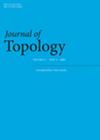Local connectedness of boundaries for relatively hyperbolic groups
IF 1.1
2区 数学
Q2 MATHEMATICS
引用次数: 0
Abstract
Let be a relatively hyperbolic group pair that is relatively one ended. Then, the Bowditch boundary of is locally connected. Bowditch previously established this conclusion under the additional assumption that all peripheral subgroups are finitely presented, either one or two ended, and contain no infinite torsion subgroups. We remove these restrictions; we make no restriction on the cardinality of and no restriction on the peripheral subgroups .

相对双曲群边界的局部连通性
让 ( Γ , P ) $(\Gamma,\mathbb {P})$ 是相对一端的相对双曲群对。那么,( Γ , P ) $(\Gamma,\mathbb {P})$ 的鲍迪奇边界是局部连通的。鲍迪奇之前是在所有外围子群都是有限呈现、一端或两端、不包含无限扭转子群的额外假设下得出这个结论的。我们取消了这些限制;我们不限制Γ $\Gamma$ 的心性,也不限制外围子群 P ∈ P $P \ in \mathbb {P}$ 。
本文章由计算机程序翻译,如有差异,请以英文原文为准。
求助全文
约1分钟内获得全文
求助全文
来源期刊

Journal of Topology
数学-数学
CiteScore
2.00
自引率
9.10%
发文量
62
审稿时长
>12 weeks
期刊介绍:
The Journal of Topology publishes papers of high quality and significance in topology, geometry and adjacent areas of mathematics. Interesting, important and often unexpected links connect topology and geometry with many other parts of mathematics, and the editors welcome submissions on exciting new advances concerning such links, as well as those in the core subject areas of the journal.
The Journal of Topology was founded in 2008. It is published quarterly with articles published individually online prior to appearing in a printed issue.
 求助内容:
求助内容: 应助结果提醒方式:
应助结果提醒方式:


